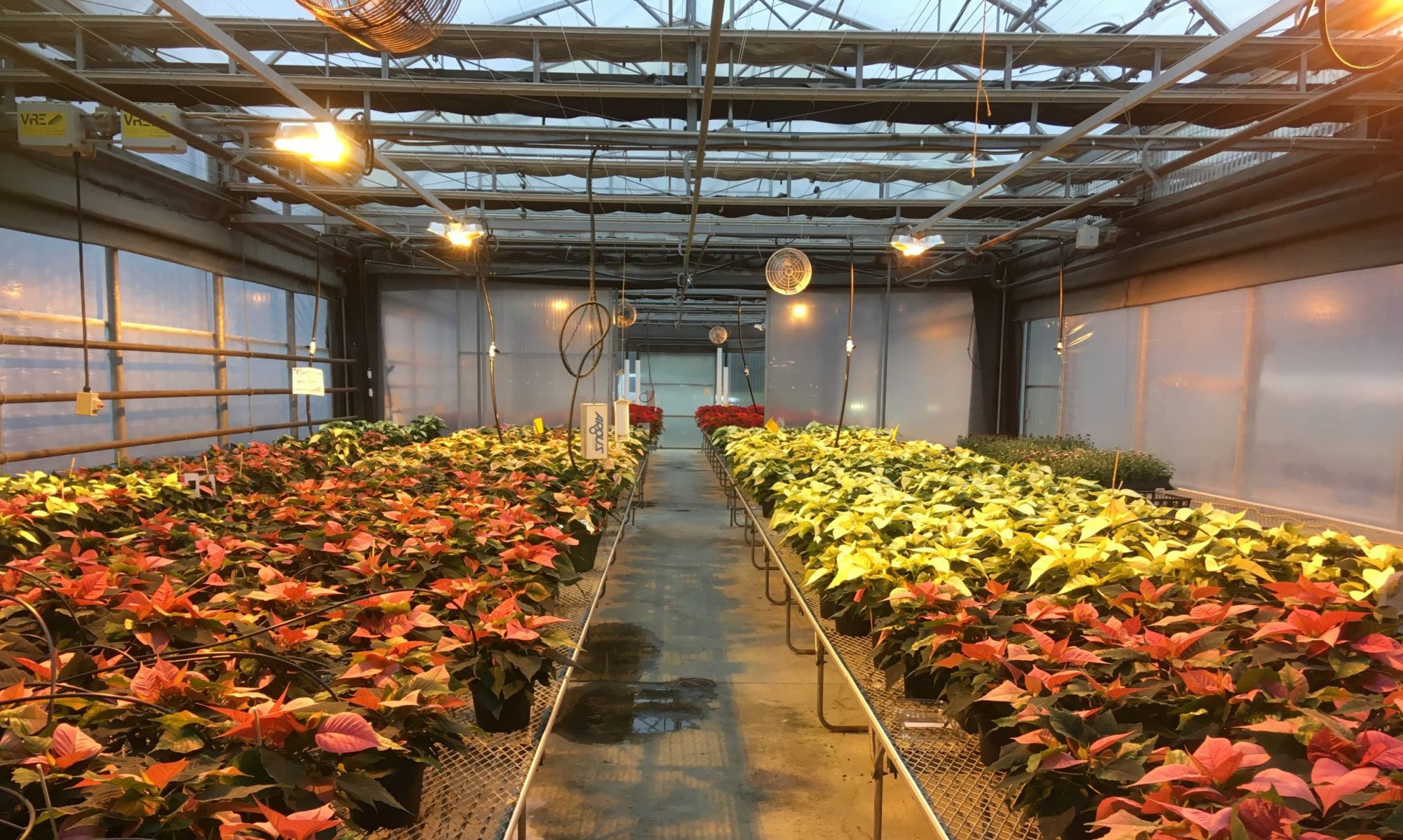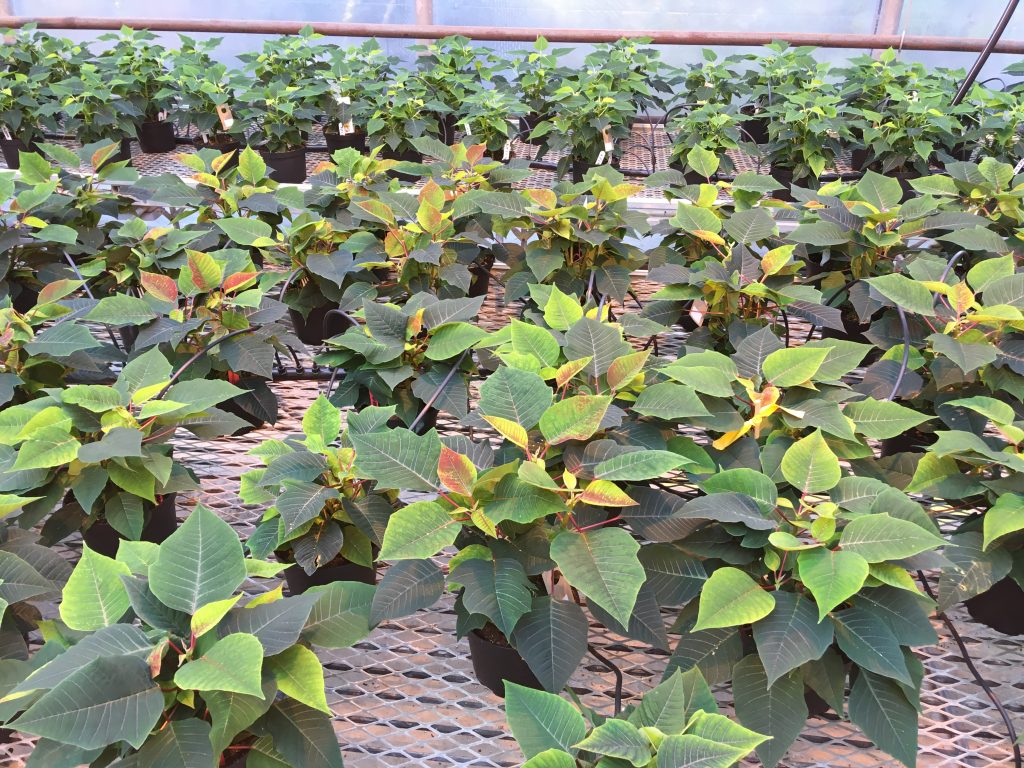To order poinsettia online to go:
https://tradesappliedtech.viu.ca/horticulture/form/poinsettias
Environmental Conditions:
Week 44 was largely sunny with day temperatures in the low teens and night temperatures dropping to 2C however, did not drop to freezing. We must consider outside temperatures and other influences, like solar radiation, when determining factors contributing to plant growth. In addition to plant growth, outdoor influences will impact the demand on our greenhouse systems like our boilers, lights, and energy curtains. We should consider not only the health of our crop but, the condition of our greenhouse system when making decisions.

Day: Heating Setpoint 20C | Cooling Setpoint 22C
Night: Heating Setpoint 18C | Cooling Setpoint 20C
Continuing our temperature regime from last week, we used Argus Controls to create two distinctive temperature zones. Our day period, which corresponds directly to our literal (or solar) day period (light is getting to the crop) is running higher temperatures than our night period; this means we are running a positive diff. A negative diff is if we were running a warmer night period than day period.
We need to ensure a greater and distinct difference between the day and night temperatures to trigger generative growth. Its important to remember that our temperature zones are dynamic, and we can change the, based on our height measurements and our visual inspections of our crop.
The students worked on their yellow sticky card assignments for HORT 112T this week and did not have a chance to record the heights for the crop. We will have to incorporate this next week
Supplemental Lighting:
We are running a 9-hour day and a 15-hour night to trigger the plants into generative growth. This is essentially what is going to turn our poinsettias red, white, or pink. We are currently in week 4 of our blackout period and seeing more colour change throughout the crop. Worth noting that daylight savings time ends this weekend. That’s great news for us, an extra hour of sleep but, what does that mean for our poinsettias crop? How will this impact our photoperiod timing? What should we take into consideration?
Hours of Black Out: 15 hours – 5pm to 8am.
Nutrient:
EC target is 1.5 – 2.0 pH target is 5.7 – 6.3
EC: Not recorded this week.
pH: Not recorded this week.
Watering/Fertilizer:
Based on high fungus gnat count in our makeshift flood tables, we decided to adjust the watering strategy and remove the flood table systems. I spaced the 4” poinsettias into trays and placed them in the same location in zone 5. The makeshift flood tables, while and excellent time saver for watering, resulted in standing water in the bottom after waterings – the perfect environment for fungus gnats, remember that they prefer conditions with standing water to lay their eggs (related to mosquitoes).
I watered the poinsettias with CaN03 fertilizer again this week to promote and encourage good bract development. The next watering should be from tank A or Mg (blue) fertilizer to ensure we are giving our crop a well-balanced diet of nutrients. Worth noting that as we get closer to our sale date we will decrease and then stop fertilizing the plants before shipping.
Observations:
- The 4” poinsettias were removed from the flood table systems and spaced in trays on the benches. This will increase the amount of time required for hand watering and subject the plants to the possibility of their leaves getting wet – perfect for disease pressures. However, we have increased the air circulation, they were getting crowded, and eliminated the perfect environment for fungus gnats (read above). A lesson we can take from this experience is that when we make an decision to change or alter our crop or the environment it grows in we should also consider what sort of negative impact (if any) will result from the decision.
- (Ignore the uncooperative number formatting)
Students did not take height measurements this week however, the crop visually looks on track as I am working in the greenhouses compared to my prior experience. Now that we have started the black out it is increasingly important to be accurate in our poinsettia height measurements. Once we have triggered generative growth the plants will focus their growth on generative and less towards vegetative growth meaning we have less flexibility when adjusting temperatures to direct crop height.
- No change to the temperature regime was made this week. It is worth noting that with the vent motor broken in zone 4, once temperatures increase, they are held in the zone throughout the day and into the night because venting isn’t possible. This results in a higher 24hour period and the impact on the crop is that they are taller than the plants in zone 4. This experience showcases that temperature has a direct influence on crop growth (height). To help regulate temperature fluctuation and to allow air flow, I have left the door between zone 4 and zone 5.
Team Citrus completed YSC Lab #2 this week and determined that fungus gnat pressures have decreased while whitefly pressures have increased in zone 4. We have changed our water management strategy to reduce environments conducive to fungus gnat population growth and applied Hypoaspis miles (predatory mite) and Steinernema feltiae (nematode) as biological controls to reduce fungus gnat populations. We also released Encarsia formosa and Eretmocerus eremicus (predatory wasps) to combat our whitefly pest pressrues.
See notes on VIULearn for biological insect applications. https://www.biobestgroup.com/

- Colour, colour and more colour! We are seeing increasing amounts of colour change in our crop as we move into the final stages of our crop production. Change is good, or so they say. In our case changing the temperature regime, photoperiod (light) and fertilizers (nutrients) is what influences our poinsettias to change colour. But, what is happening internally in our poinsettias to cause the change in colour? In the vegetative growing period, our poinsettias were producing chloroplast-contained cells, which is the green colour we see. In the generative (flowering) period our poinsettias are producing anthocyanins. Anthocyanins is a compound plants produce when subjected to change in environment (read above) and is essentially the colour we are seeing and can be found in other crops like red cabbage and blueberries. Anthocyanin production is a plant’s last effort to stored energy to endure the “winter” season.
You can read more about anthocyanin production in plants here:
https://www.quora.com/How-do-the-leaves-of-poinsettia-plants-turn-red
https://science.howstuffworks.com/life/botany/leaves-turn-red1.htm
6. Moving forward we will continue to monitor plant heights, EC/pH, pest pressures and environmental conditions to make decisions to impact plant health as we head into the final growing stages of our production schedule. Students should now be starting their sales section for their blog and can find resources to support this on VIULearn. In the coming weeks we will work together in our face to face classes to grade our poinsettias and practice packaging methods before shipping starting December 1.








